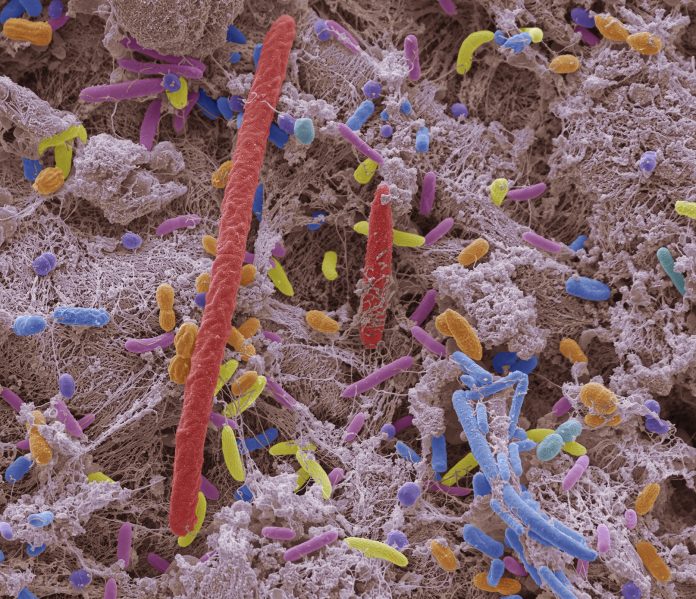Tuberculosis
Tuberculosis (TB) is an infectious disease caused by the bacterium Mycobacterium tuberculosis (M. tb.). While it generally affects the lungs, it can also affect other parts of the body. Most infections show no symptoms, known as latent tuberculosis, with roughly 20% of the world’s population infected. Latent TB can progress to active disease in about 10% of cases, and, if left untreated, it kills about half of those affected. There were more than 10 million cases of active TB in 2018, resulting in 1.5 million deaths. This makes TB the number one cause of death from an infectious disease in the world.

Treatment for TB is not easy, requiring several antibiotics to be taken for six to nine months. Long-term antibiotic use comes with a host of problem including liver damage, antibiotic resistance, and permanent changes to the gut microbiome [1]. These changes are linked to a variety of chronic health conditions including diabetes and obesity. Antibiotics are like dropping a bomb on the microbial community, indiscriminately killing both harmful and beneficial bacteria. Ideally, TB treatment would involve targeted killing of only Mycobacterium.

The Achilles Heel
Cells cannot function without iron, which they scavenge from their surroundings with iron-binding siderophores. The production of the siderophore mycobactin (MBT) by Mycobacterium is essential for survival within its human hosts. Mycobactin binds to iron more strongly than host siderophores, and is its primary iron-acquisition mechanism. In culture, MBT knockout mutants were essentially unable to grow, regardless of how much iron you added, and no mutant M. tb. was found in guinea pigs after 4 or 10 weeks post-infection [2]. Also, the transporter for MBT is unidirectional – once bound with the oh-so-precious iron, the bacteria does not want to risk losing it. All this makes MBT an intriguing target for study …
Carbon Nanomaterials
Of the various carbon nanomaterials (CNM), fullerenes and single-wall nanotubes (SWNTs) are highly bactericidal, disrupting cell membranes and the electron transport chain [3]. Many forms of CNM are naturally occurring from combustion processes [4]. Carbon nanomaterials are highly insoluble until functionalized by chemical oxidation. This processes involves using strong acid to create carboxylic acid, ketone, alcohol and ester groups on the CNM [5], which then serve as tether points for more complex molecules.

Better Than Antibiotics
Now to the punchline: I propose attaching mycobactin to functionalized fullerenes or SWNTs as a non-antibiotic, targeted cure for tuberculosis. While the mechanisms of iron import in M. tb. are still under investigation, the IrtAB transporter nicely transports both forms of mycobactin, allowing flexibility in choice of mycobactin for study [6]. Whether the MBT-CNM can be fully transported into the cell is of course unknown, but this is only one of a variety of ways the modified nanomaterials could harm the cell. The MBT-CNM could act synergistically, either clogging the transport permease, stress the cell with reactive oxygen species – which is already a problem for the cell when handling iron (and without iron, no anti-ROx Fe-SOD!), or could drain the cells energy reserves needed to transport, reduce, and release the iron-mycobactin.
In addition to killing TB, this use of nanotechnology would be a proof-of-concept for a tool capable of removing a single species from a microbiome. Cutting edge next-gen sequencing continues to reveal previously unknown roles for specific microbes living on and inside us. Once we figure out the interplay of host-microbe and microbe-microbe interactions, we will need tools for restructuring the community or removing troublesome species. Genome mining could reveal the distinct functions for species that then can be targeted using similarly modified nanomaterials. Heme, specific sugars, secondary metabolites, … etc, could all be tested to see what compounds are being used by and/or affect which microbe-microbe/host interactions.
Cytotoxicity
Damage to human cells, is of course a concern. In 2020, glycine-fullerene conjugate was effectively used against the bacterium P. acnes without any identified cytotoxicity against human fibroblasts [7]. Elsewhere, fullerenes were not found to be toxic to alveolar (lung) macrophages, and short nanotubes were similarly shown to have low cytotoxicity [8]. While nanotubes can disperse themselves systemically, they appear to be quickly excreted in lower order eukaryotes [9]. I’ll spare myself the huge investment of time in doing a full literature review on the topic of nanotube toxicity. Instead, I suggest we just test the new MBT-CNMs on a few dozen different human cell types.
The Experiments
Materials
1. Collaborators. You need someone(s) with human cell culture, microbiology, organic chemistry, and nanomaterial experience. Yes, you will have to leave your lab building and make friends in other fields, schmooze, bring cookies and/or beer.
2. You can buy mycobactin from one of the big bio suppliers (they keep merging so just google where to get it)
3. You’ll need the harmless version of Mycobacterium (M. smegmatis) and some other harmless-ish human microbes (E. coli, S. pyogenes, B. subtilis) obtained from ATCC. You should also get the human microbiome project’s mixed bacterial community glycerol stock.
4. Buy, borrow, beg, or barter the various human cell culture media and cell types. !- make sure you have the right kind of incubator, the human cells need CO2
5. Formalin causes molecules to form covalent bonds to one another, so get some of this too.
6. Petri dishes, pipet tips, RNA extraction kits, microscopes, minions .. all the usual trappings of a microbiology lab
7. Also, probably some admin has to approve this with the usual extensive bureaucracy.
Methods
Making MBT-CNM: You’ll need to test various combinations of formalin, mycobactin, and nanotubes/fullerenes concentrations (and probably have a long chat over coffee/beer with whatever chemist is helping you) to make sure you are getting a roughly 1:1 MBT-CNM. I also suspect you’ll need to add some kind of sugar or other polar small molecule at a low level to help solubility and, if using nanotubes, reduce toxicity. The ends of nanotubes are more reactive, so you may be able to simply ask your local organic chemist what can facilitate the reaction between CNM-COOH + MBT. You’ll probably want to attach to one of the middle double bond oxygens if possible. Check some NMR or similar spectrum to make sure you made what you want. I suspect the creation will need to be very dilute to reduce the chance of getting weird MBT + CNM ratios, and thus need to be concentrated in a CentriVap.
Simple MIC Tests: try a dilution series on spread plates with M. smegmatis and the other microbes. This way you can find at what concentration the pristine, functionalized, and modified NMs are needed to kill each type of bacteria. Once you have your Minimum Inhibitory Concentration (MIC), test a few concentrations below and above that on your different human cell types. Check out viability and visible phenotype of both human and non-Mycobacterium species.
Transcriptome: Just because the non-M. smeg. cells are alive doesn’t mean they are ok. Do a quick shotgun transcriptome to make sure there are no important unseen changes in the human and bacterial cells. Bacteria only have some thousands of genes, and for all species (including human) you are doing a simple direct comparison = you can multiplex a bunch of samples. That way you wouldn’t need more than a few lanes (replicates), and since you are just doing straight subtractive comparison of known species, you can go with shorter 25-50nt reads to capture any effect in miRNA too.

Why haven’t you done this already?
While working on Frankia toxic metal resistance for my Ph.D., I did comparative gene analysis with closely related species, including Mycobacterium. During the analysis I discovered that the mycobactin genes were not found in any of the species I examined except Mycobacterium. I was excited that, as explained above, mycobactin was required for growth and virulence. Naturally, my PI and thesis committee were only concerned with getting me graduated, from which I was less than a year out, so I pocketed the idea for later. Once I graduated, I pursued an education technology start-up (Eddefy) in California, which my co-founders and I started during my Ph.D work. Living on the money from selling my car and all possessions of value, couch surfing with friends, owning nothing but student loan debt, spending all my time pitching to investors, I was in no position to move on TB.
During this time I discussed the concept of using MBT-CNM with several researchers around the West coast, but all were too busy with their own projects to run the ball. While out in Cali, after being diagnosed with cancer #2, this time melanoma, and with barely enough scrounged money to keep my start-up gaspingly alive, I decided to table Eddefy and return to academia to complete a post-doc. There too I tried to get takers for testing a cure for TB, and again everyone was too busy, even the person at University of Michigan actually studying Mycobacterium. The melanoma went metastatic right at the end of my postdoc, killing my hope for a faculty position where I could test my hypothesis.
In Summary
My battle with cancer is not going so well. So this public posting is the best I can do for the millions of people who will otherwise die of TB. Between the inherent cytotoxicity of the nanotubes, the unidirectional transport of the mycobactin, its specificity to M. tb. and the low human toxicity, I think this has a pretty darn good chance of working. Hopefully my public release will keep some pharmaceutical company from patenting and sitting on this cure, though typically big pharma doesn’t really care about diseases that mostly just affect developing countries. Please someone, please at least try this.

References:
- https://www.frontiersin.org/articles/10.3389/fmicb.2020.00053/full
- https://academic.oup.com/jid/article/208/8/1255/2192581#83216205
- https://www.mdpi.com/1996-1944/10/9/1066/htm
- https://bmcchem.biomedcentral.com/articles/10.1186/1752-153X-7-154#Sec4
- https://www.intechopen.com/books/carbon-nanotubes-polymer-nanocomposites/functionalization-of-carbon-nanotubes
- https://www.nature.com/articles/s41586-020-2136-9#Sec1
- https://www.tandfonline.com/doi/abs/10.1080/1536383X.2020.1825388
- https://particleandfibretoxicology.biomedcentral.com/articles/10.1186/s12989-019-0299-z
- https://bmcchem.biomedcentral.com/articles/10.1186/1752-153X-7-154#Sec4

You must be logged in to post a comment.